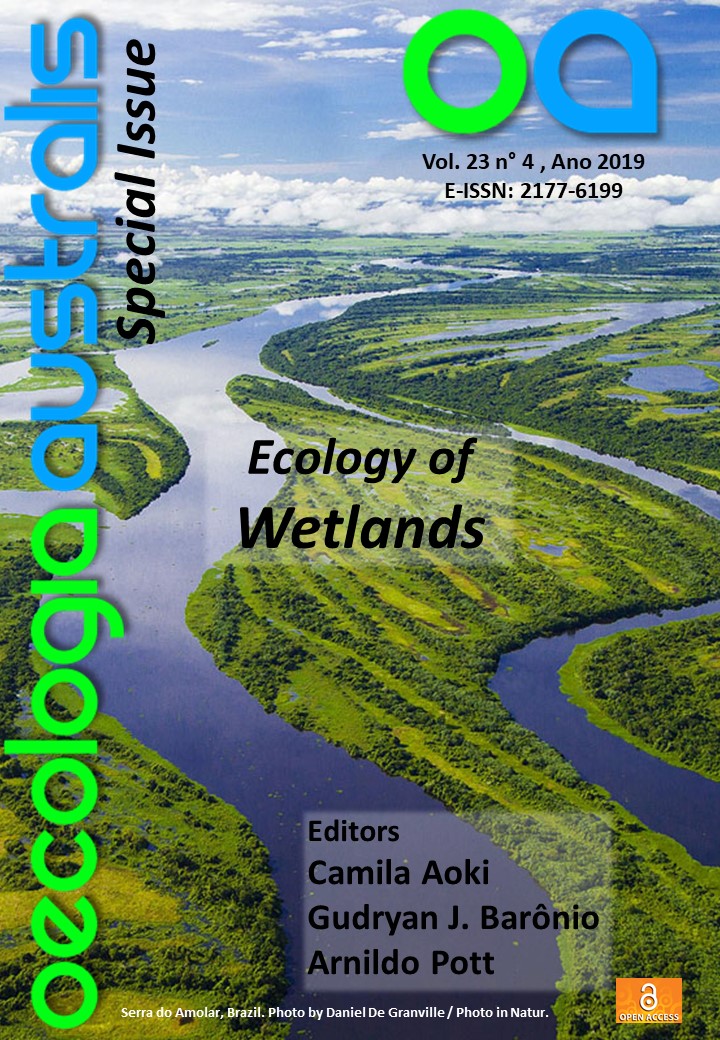EFFECT OF TEMPERATURE AND RELATIVE HUMIDITY ON THE BEHAVIOR OF CAPYBARAS (Hydrochoerus hydrochaeris) IN AN URBAN AREA
DOI:
https://doi.org/10.4257/oeco.2019.2304.32Keywords:
anthropized area, aquatic activity, thermoregulationAbstract
The capybara, Hydrochoerus hydrochaeris (Rodentia, Caviidae), is a species adapted to diverse environments, including urbanized areas, where its populations can reach high densities. In this study, we searched the behavioral pattern of capybaras in urban areas, and investigated the effect of temperature and relative humidity in its activity pattern. The study was conducted in an urban area of the Aquidauana municipality in the state of Mato Grosso do Sul, Brazil. Observations occurred between June 2014 and March 2015, using the scan sampling method. We found that capybaras spent most of your time in aquatic activities and rest. Temperature was positively correlated with the percentage of individuals engaged in aquatic activities. Relative humidity was negatively correlated with the percentage of individuals at rest and positively correlated with aquatic activities. Capybaras exhibit behavioral thermoregulation, which explains the large amount of time spent on aquatic activities with the increase in temperature and relative humidity.
Downloads
References
Altmann, J. 1974. Observational study of behavior: sampling methods. Behaviour, 49(3/4), 227-267.
Azcarate, T. 1980. Sociobiologia y manejo del capibara (Hydrochoerus hydrochaeris). Donana Acta Vertebrata, 7(6),1-228.
Blake, J. G., Mosquera, D., Loiselle, B. A., Swing, K., Guerra, J., & Romo, D. 2012. Temporal activity patterns of terrestrial mammals in lowland rainforest of eastern Ecuador. Ecotropica, 18(2), 137-146.
Borges, P. A. L., & Tomás, W. M. 2008. Guia de rastros e outros vestígios de mamíferos no Pantanal. Corumbá: Embrapa Pantanal: p. 148.
Cabanac, M. 1979. Le comportement thermorégulateur. The Journal of Physiology, 75, 115-178.
Carvalho, W. D., Freitas, L. N., Freitas, G. F., Luz, J. L., Costa, L. M., & Esbérard, C. E. L. 2011. Efeito da chuva na captura de morcegos em uma ilha da costa sul do Rio de Janeiro, Brasil. Chiroptera Neotropical, 17(1), 808-816.
Everts, L. G., Strijkstra, A. M., Hut, R. A., Hoffmann I. E., & Millesi, E. 2004. Seasonal variation in daily activity patterns of free-ranging European ground squirrels (Sermohilus citellus). Chronobiology International, 21(1), 57-71. DOI: 10.1081/CBI-120027982
Fernandez-Duque, E. 2004. High levels of intrasexual competition in sexually monomorphic owl monkeys (Aotus azarai). Folia Primatologica, 75, 260.
Ferraz, K. M. P. M., Manly, B., & Verdade, L. M. 2010. The influence of environmental variables on capybaras (Hydrochoerus hydrochaeris: Rodentia, Hydrochoeridae) detectability in anthropogenic environments of southeastern Brazil. The Society of Population Ecology, 52(2), 263-270. DOI: 10.1007/s10144-009-0181-1
Halle, S., & Stenseth, N. C. 2000. Activity patterns in small Mammals: An ecological approach. Springer, Berlin, Germany: 320 p.
Moreira, J. R., & MacDonald, D. W. 1997. Técnicas de manejo de capivaras e outros grandes roedores na Amazônia. In: C. Valladares-Padua, R. E. Bodmer, & L. Cullen-Jr (Eds.), Manejo e conservação de vida silvestre no Brasil. pp. 186-213. Belém, PA: Sociedade Civil Mamirauá.
Norris, D., Michalski, F., & Peres, C. A. 2010. Habitat patch size modulates terrestrial mammal activity patterns in Amazonian forest fragments. Journal of Mammalogy, 91(3), 551-560. DOI: 10.1644/09-MAMM-A-199.1.
Peel, M. C., Finlayson, B. L., & McMahon, T. A. 2007. Updated world map of the Köppen-Geiger climate classification. Hydrology and Earth System Sciences, 11(5), 1633-1644. DOI: 10.5194/hess-11-1633-2007
Pereira, H. F. A., & Eston, M. R. 2007. Biologia e manejo de capivaras (Hydrochoerus hydrochaeris) no Parque Estadual Alberto Löfgren, São Paulo, Brasil. Revista do Instituto Florestal, 19(1), 55-64.
Rickli, R. I., & Reis, N. R. 2014. Método de estudo para avaliar dieta, atividades e locais ocupados por capivaras Hydrochoerus hydrochaeris (Linnaeus, 1766). In: N. R. Reis, A. L., Peracchi, B. K. Rossaneis, & M. N. Fregonezi (Orgs), Técnicas de estudos aplicadas aos mamíferos silvestres brasileiros. pp: 193-199. Technical Books Editora.
Sábato, M. A. L., Melo, L. F. B., Magni, E. M. V., Young, R. J., & Coelho, C. M. 2006. A note on the effect of the full moon on the activity of wild maned wolves, Chrysocyon brachyurus. Behavior Processes, 73(2), 228-230. DOI: 10.1016/j.beproc.2006.05.012
Santos, C. R., Ortêncio-Filho, H., Barbosa, O. R., Cardozo R. M., Araújo, D. N., Fornari, D. C., Guaragni, M., & Fregadolli, R. M. 2005. Etologia de capivaras (Hydrochaeris hydrochaeris L. 1766) jovens semiconfinadas no Norte do Estado do Paraná. Acta Scientiarium - Animal Sciences, 27(1), 163-169. DOI: 10.4025/actascianimsci.v27i1.1262
Souza, B. B., & Batista, N. L. 2012. Os efeitos do estresse térmico sobre a fisiologia animal. Agropecuária Científica no Semiárido, 8(3), 06-10.
Souza, E. P., & Martins, S. R. O. 2010. Conflitos territoriais no entorno do Parque Natural Municipal da Lagoa Comprida em Aquidauana/MS. Percurso: Sociedade, Natureza Cultura, 11, 291-306.
Takahashi, L. S., Biller, J. D., & Takahashi, K. M. 2009. Bioclimatologia zootécnica. Jaboticabal: p. 91.
Terrien, J., Perret, M., & Aujard, F. 2011. Behavioral thermoregulation in mammals: a review. Frontiers in Bioscience, 16(4), 1428-1444. DOI: 10.2741/3797
Tobler, M. W., Carrillo-Percastegui, E. S., & Powell, G. 2009. Habitat use, activity patterns and use of mineral licks by five species of ungulate in south-eastern Peru. Journal of Tropical Ecology, 25(3), 261-270. DOI: 10.1017/S0266467409005896.


